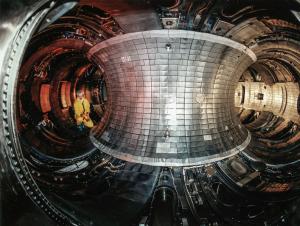US National Academies
"US should remain in ITER"
17 Dec 2018
The US National Academies of Sciences, Engineering, and Medicine has completed a multiyear study of the overall status of magnetic confinement fusion research in the United States. Its recommendation? Continued US participation in the ITER Project and an unambiguous increase in funding for the domestic fusion program leading to the construction of a compact pilot plant.
The Tokamak Fusion Test Reactor (TFTR) operated at Princeton Plasma Physics Laboratory (PPPL) from 1982 to 1997. It is the only machine, with the European JET, that implemented the actual fusion fuels deuterium and tritium plasmas, producing significant levels of fusion power. The Committee on a Strategic Plan for Burning Plasma Research now recommends that the United States start a national program leading to the construction of a compact pilot plant. During the course of its investigations, the Committee visited ITER, General Atomics (DIII-D tokamak), and the Princeton Plasma Physics Laboratory (NSTX tokamak).
The Final Report of the Committee on a Strategic Plan for Burning Plasma Research was the latest in a number of steps undertaken by policymakers in the United States to evaluate the state of domestic fusion research—including current and planned participation in international programs—and to develop a strategic plan for the future.
In 2016, after a detailed evaluation of the ITER Project, the US Department of Energy issued a report to Congress recommending continued US participation in 2017 and 2018 as "in the best interest of the nation." The report also suggested a re-evaluation of US participation based on project progress prior to the Fiscal Year 2019 budget submittal.
The committee formed to carry out this re-evaluation—the Committee on A Strategic Plan for U.S. Burning Plasma Research—delivered an interim report one year ago on the importance of burning plasma research to the development of fusion energy as well as to plasma science and other science and engineering disciplines. In it, ITER was highlighted as "the only existing project to create a burning plasma at the scale of a power plant."
The final report issued this month makes two recommendations:
- First, the United States should remain an ITER partner as the most cost-effective way to gain experience with a burning plasma at the scale of a power plant.
- Second, the United States should start a national program of accompanying research and technology leading to the construction of a compact pilot plant that produces electricity from fusion at the lowest possible capital cost.
"ITER is a burning plasma experiment and the critical next step in the development of fusion energy. It is a large and ambitious project that integrates multiple advanced technologies and combines the scientific and engineering expertise, industrial capacity, and financial resources of many nations. As a partner, the United States receives full benefit from the technology developed for ITER while providing only a fraction of the financial resources. Methods to control the plasma and extract the electricity-producing heat will be tested and developed. U.S. industry is building major systems for ITER and thereby gaining expertise in fusion engineering science and building industrial capabilities." [Executive Summary]
See the press release for more information or to download the full report.


